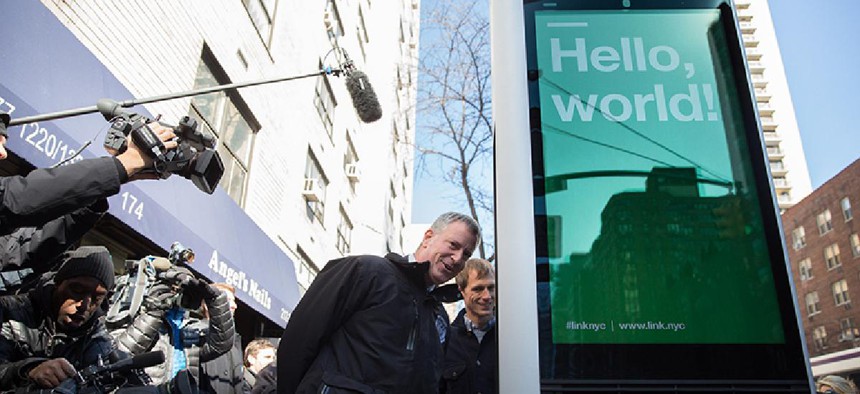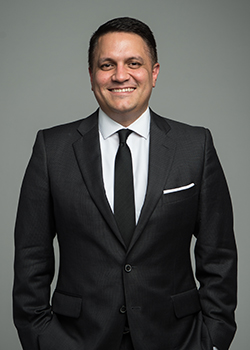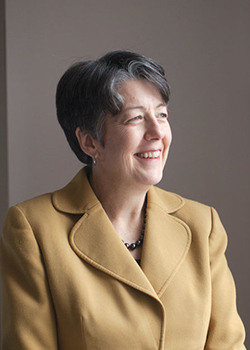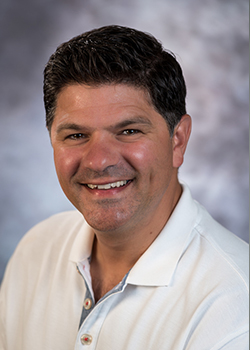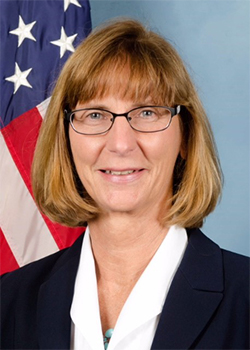It’s no surprise that politicians of all stripes make a point of touting the promise of technology.
Progressives praise the ways in which it can increase transparency and improve government responsiveness. Conservatives seek to use it to cut costs and make government more efficient. And members of both parties see it as a way to spur economic growth and create jobs, both in urban centers like New York City and in less populated regions in upstate New York.
Of course, technology is no panacea. Any number of projects have underperformed or been mired in controversy, from the city’s efforts to overhaul the CityTime payroll system to the corruption allegations surrounding the state’s tech-driven upstate economic development initiatives.
Yet technology is dramatically changing how we all live, often in ways that weren't anticipated a few years ago. Government officials are scrambling to catch up and figure out the best way to respond to new services like ride-hailing apps and vacation rental websites. They’re deciding whether to embrace innovations like self-driving cars. And they’re confronting the competitive pressures that arise from disruptive new technologies.
In this special section on technology and telecommunications, City & State checks in with key officials who are driving digital policy in the city and state – and how they’re reacting to a shift in policy in Washington, D.C.
RELATED: Bringing the resistance to the web
Miguel Gamiño Jr.
New York City Chief Technology Officer
C&S: Part of your job involves implementing an “internet of things” strategy throughout city agencies. What does that mean?
MG: Internet of things is about interconnecting devices and infrastructure and inanimate objects, machines, so they can benefit from the same information and data exchange, potentially making decisions based on rules and algorithms to either collect and send data to humans to make those decisions better and faster, or in some cases to make decisions on their own to improve the overall service delivery.
C&S: The city Department of Information Technology and Telecommunications has overseen the recent rollout of LinkNYC. Are there any related upcoming projects you're excited about?
MG: Me being hired into New York (from San Francisco, where Gamiño was chief information officer), among other things, was about kind of consolidating and creating focus on the broader broadband picture. So, LinkNYC will certainly play an important role in both our broadband and potentially our internet of things strategy. But it is one piece in a bigger plan that we are working to put all the details together on.
C&S: Former New York City Chief Digital Officer Sree Sreenivasan departed last month, and Mayor Bill de Blasio called for centralizing digital strategy under your chief technology officer position. How has that gone?
MG: It's something that I was involved in anyway because they're so closely related. I think we're benefiting already from sharing resources and information and identifying more clearly how these different areas intersect so naturally. It's easier for people outside to understand who to contact or the technology conversation. It's not so much about what Sree did or didn't do, or a comparison about him or me. Having one person to go to for all of these different elements of a broader technology conversation just makes a lot of sense to everyone I've spoken to. So I think it's been a very logical step and transition and one that's been very well received.
Anne Roest
Commissioner, New York City Department of Information Technology and Telecommunications
C&S: The New York City Department of Information Technology and Telecommunications recently began implementation of LinkNYC, which provides free Wi-Fi service through kiosks in the city. Was the rollout of LinkNYC a success? Are there any plans for further expansion?
AR: Absolutely. The numbers tell a story of terrific success to date: 850 links active across the five boroughs, and over 1.7 million subscribers who have used more than 1.4 petabytes of data. That’s the equivalent of sending more than 10 billion emails, streaming 1 million hours of video, sending 37 billion WhatsApp messages or streaming 174 million songs. By the time it's fully deployed, there will be nearly 10 times as many kiosks as the number on the street now – at least 7,500, ultimately adding up to the world’s largest and fastest municipal Wi-Fi network.
C&S: Are there any upcoming projects by DoITT that apply new technological innovations for city improvement?
AR: Absolutely – text-to-911 and NextGen911 are great examples. In today's world, given what people can do and how they communicate with personal devices, we need to step up our 911 capacity accordingly. Text-to-911 and Next Generation 911 are going to do just that by providing the ability to transmit photos, videos, use social media, etc. to engage with emergency services. More generally speaking, we're adjusting how we deliver services to be more cloud- and software as a service-driven.
C&S: In March, New York City Mayor Bill de Blasio announced a lawsuit against Verizon for failing to expand fiber-optic service to New York City. What role does the DoITT play in encouraging internet service providers to expand to New York?
AR: New York City sued Verizon because the company failed to live up to its promise to bring fiber-optic cable to every household in the city – by a number of years and millions of households. Generally, we're always thinking about ways to attract more internet service providers, especially encouraging smaller companies to explore becoming a franchisee with the city. We also partner with and support the chief technology officer on executing the mayor's pledge to bring affordable, reliable high-speed broadband to every New Yorker by 2025.
C&S: A labor dispute with Charter Communications has led to a strike of around 1,800 IBEW Local 3 workers. De Blasio said he was willing to “step in” to help settle the conflict. Would the city Department of Information Technology and Telecommunications become involved in any efforts to help resolve this dispute?
AR: It's very unfortunate that this dispute has gone on for so long, with so many workers on the picket line. DoITT is very carefully monitoring the situation and has been in communication with both the union and our franchisee. The franchise agreement explicitly permits the right of workers to bargain collectively through their union, and the administration is equally explicit in its desire for the workers to swiftly receive a fair contract. Our contract mandates that Charter negotiate in good faith, but we don't have legal standing to force a particular resolution. We are very hopeful that this will be resolved and the workers will get their due very soon. It's time for them to go back to work.
RELATED: Lawmakers home in on Airbnb
George Amedore
Chairman, state Senate Select Committee on Technology and Innovation
C&S: The Select Committee on Technology and Innovation was announced in January. What was the reason for creating the committee?
GA: We are living in a digital economy and we should be a leader when it comes to technology. The select committee was formed so that we could focus on what barriers exist, what current laws and statutes prohibit the advancement of technology or creation of business. New York should be in the forefront of the innovation and technology era, and it's been clear that we have not been.
C&S: Are there any specific initiatives that the committee is planning on undertaking in the coming months?
GA: Our main goal is to support the growth and development of tech-related businesses, also to encourage new innovation, which will generate economic growth and career opportunities for New Yorkers. The committee has been and will continue to meet with the various stakeholders within the industry to identify what steps we need to take legislatively that will help these industries thrive. The plan that we have is to continue to strategize, listen, talk with the stakeholders to develop a plan of action that (would) remove the barriers, help businesses, technologies, privacy issues and funding issues across the board.
C&S: Will the committee plan any initiatives specifically for upstate New York?
GA: I represent The Capital Region area and Hudson Valley – part of the Hudson Valley region. I am tired of seeing our young people leaving upstate New York for more exciting and better opportunities elsewhere. I think that our focus needs to be how we can retain our talent and the potential leaders in the future workforce for upstate New York. One thing that we know about the millennial generation is the millennials are definitely very much more tech savvy than the Gen X or baby boomers. We need their expertise and their brainpower, but also their vision and energy to help drive this economy.
Terri Egan
Executive Deputy Commissioner, state Department of Motor Vehicles
C&S: Gov. Andrew Cuomo announced regulations for ride–hailing services throughout New York earlier this month. What will the state Department of Motor Vehicles’ role be in monitoring ride-hailing companies?
TE: It’s a fairly extensive statute. DMV has promulgated regulations that have been posted to our website and are available for viewing that will enable ride-sharing to be operational by June 29, the effective date of the legislation.
C&S: You took the inaugural ride in an Audi autonomous vehicle on June 13, as part of the state’s new program for testing self-driving technology in New York. Will the DMV continue to oversee tests of these cars going forward?
TE: Legislation was passed and signed by Gov. Cuomo establishing a one-year pilot for the autonomous vehicle technology, whereby entities can apply to the Department of Motor Vehicles, as well as the state police, to get approval for tests and demos over the next one-year period, and then they submit data to us that we will then be using to submit a report to the Legislature and to the governor.
C&S: Is the DMV using any other new technology or innovations to make New York roads safer?
TE: I think we're pretty innovative with what we do, and we certainly are always looking for different things that we can be doing. One of the things that we've been doing in conjunction with one of the governor's initiatives for open road tolling is the use of license plate readers. These are devices in which we can load specific data, for example, registration information for vehicles that have been suspended or revoked. In the event that a law enforcement vehicle that has the LPR technology observes one of these vehicles, alarms go off and it will alert one of these law enforcement so they could pull that suspended or revoked vehicle over and then issue the appropriate citations … It's a different way to use technology that will have the benefit of making New York roads safer.

